New Jersey Future Blog
Landmarking the Legacy of NJ Transgender Icon, Venus Pellagatii Xtravaganza
July 20th, 2023 by Sneha Patel
“It is necessary to invoice Venus’s story, not only through black history, but through Latinx history and queer history. It is too important to excavate this kind of history, so what happened to Venus won’t happen again because it continues to happen.” expressed Michael Roberson, Professor, New School and Union Theological Seminary at the 2023 Planning and Redevelopment Conference hosted by the New Jersey Chapter of the American Planning Association and New Jersey Future. Landmarking cultural and historical sites allows for stories to persist and for cultural awareness to spread. Venus Pellagatti was a Latinx, transgender icon and her narrative established an important foothold for increased acceptance of her community and serves as a lesson in the value of preserving underrepresented experiences. Recently, Venus Pellagatti’s childhood home has been designated as a historic landmark in Jersey City.

The virtual session Landmarking the Legacy of Venus Pellagatii Xtravaganza at the 2023 NJ Planning & Redevelopment Conference. Top row from left to right: Tanya Marione, Planning Director, City of Jersey City; Maggie O’Neill, Senior Historic Preservation Specialist; Gisele Alicea Xtravaganza, Mother, House of Xtravaganza. Bottom row from left to right: Sara Quinlan, Historic Preservation Specialist; Michael Roberson, Professor, New School and Union Theological Seminary.
The captivating session recounted the life of Venus Pellagatti Xtravaganza and the process of immortalizing her legacy that continues to inspire many by landmarking her home. Moderated by Tanya Marione, Planning Director, City of Jersey City, the panelists include: Sara Quinlan, Historic Preservation Specialist; Gisele Alicea Xtravaganza, Mother, House of Xtravaganza; Maggie O’Neill, Senior Historic Preservation Specialist; Michael Stafford, pro bono civil rights attorney and producer; Michael Roberson, Professor, New School and Union Theological Seminary.

A still image of Venus Xtravaganza, interviewed in her home, taken from the documentary film Paris is Burning directed by Jennie Livingston.
Venus Pellagatti, born in 1965, moved into her grandmother’s house in 1977 in Hamilton Park on 343 1⁄2 Eighth Street. Her grandmother was one of the only family members that accepted her identity at the time, Sara Quinlan explained. Venus attended numerous LGBTQ+ clubs in Jersey City and New York City with her grandmother where she was introduced to Ball Culture, drag-centric competitive performance consisting of dramatic dancing and posing. In 1985, Venus was approached by director Jennie Livingston, who would record interviews of Venus taken in her bedroom for the groundbreaking and massively influential Paris is Burning film released in 1990. The breakthrough film went on to win numerous awards and accolades, while establishing Venus’s legacy of inspiration for modern works, such as the TV series Pose and RuPaul’s Drag Race, and become a literary reference for feminist scholar Judith Butler. Being excluded from work opportunities due to her identity, Venus began sex work in her early 20s. Venus was tragically murdered in 1988 at the age 23 by a client in an unsolved case, before the release of Paris is Burning, but her legacy continues through her story and influence.
Ballroom culture emerged from the kinship of black queer people and the escape from societal homophobia and racism. Especially during the divisive time of the 1982 HIV/AIDS crisis, the House of Xtravaganza — the first real Latinx house — opened up the space for the queer community, explained Roberson. He emphasized the humanity in Venus’ impact, “Venus is a local trans woman who’s history has a global impact…not only impacting Latinx trans women, but African American trans women, [and] European trans women.” Venus’ interviews were raw and relatable which connected with trans women and her murder displayed the dangers that they encounter even today. Gisele Aliciea Xtravaganza stressed the importance of this discussion in providing support to the trans community. Gisele remarks “Venus grew up in an era where she had it rough, but it is still rough living this lifestyle so it’s just as important today..this is a message of hope, of love, and support for our community, for Venus, the house, and transgender women, nobody is more human than the next.”
Landmarking Venus’ legacy was a difficult process. The landmarking team studied the Stonewall National Monument and a thematic study on LGBTQ sites conducted by the National Park Service to assist their efforts. Maggie O’Neill explained “This site is the only extant, tangible, historical connection to Venus’s life and her role in Ball Culture”. Venus’s home, where the Paris is Burning interviews were filmed, was established as a cultural landmark under the National Historic Preservation Act through association with a significant person. Unfortunately, because of the existing framework, they could only designate her childhood home to landmark her legacy even though she has a much wider net of her impact.
“We need to look at different ways to both require that information and also work around the existing frameworks to make sure we’re representing everyone and not just the people who it’s easiest to represent.” –Maggie O’Neill, Senior Historic Preservation Specialist
O’Neill expanded on the impact of this landmarking process. Criterion B, the framework through which Venus’ house was recognized, is the hardest to designate because of the rigid standard of documentation and many cultural histories and underrepresented groups don’t have a site or scholarly research to use. “We need to look at different ways to both require that information and also work around the existing frameworks to make sure we’re representing everyone and not just the people who it’s easiest to represent,” O’Neill emphasized. Venus’s landmark was the first strictly cultural landmark in Jersey City and the first Ballroom-related landmark in the country. It was crucial that the landmarking team fleshed out the designation to represent all of Venus’s legacy and not just the house. “Most of these cultural landmarks are things that are often evolving”. Cultural guidelines need to take this into consideration,” O’Neill observed.
Venus was a symbol to her community and continues to be. Michael Stafford explained the landmarking process came to fruition after her story started to “take a life of its own” by people online, albeit well-intentioned. Jersey City was important to her because it gave her the ability to live her true life near the people that supported her, including the continued support of the Pellagati family, who encouraged the designation process. This landmark represents the convergence of two families, the Pelattis and the Xtravaganza. “Often these two things are separated and usually the ballrooms become the family because the birth family is not accepting. But in this instance, it’s an intersection of two families and so it becomes a contemporary issue.” Robeson pointed out.
In a callback to the way Venus died, Micheal Robeson illuminated several tragic but important cases of black and/or LGBTQ+ people being brutalized for their existence and their bravery to go on to be an example for history for others to learn from. These stories repeatedly re-emerge in conversation and become immortalized in history as a cautionary tale. Venus, and those with experiences similar to hers that start with non-acceptance and end with violence, reveal the significance of a legacy, and the importance of knowledge. What can unfold because of Venus’s landmark can be monumental and that lasting impact is what this landmarking project does for the black, brown, and LGBTQIA community. “If we lose these stories, we lose the very thing that makes our city so special.” Tanya Marione concluded.
Next Stop: Transit Friendly Communities and TOD Opportunities
July 20th, 2023 by Zeke Weston
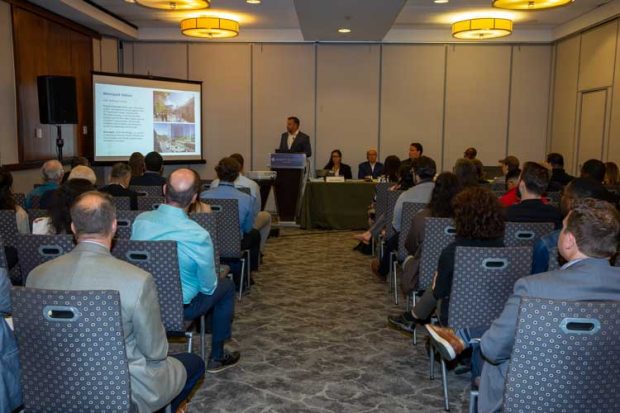
Next Stop: Transit Friendly Communities and TOD Opportunities session at the 2023 NJ Planning & Redevelopment Conference. Photo by Frank H. Conlon
Transit-friendly planning is a proactive, transit-focused approach developed by NJ Transit that is applicable to any community. Transit-friendly planning and transit-oriented development (TOD) are important components of smart growth because they allow people to live, work and play without having to rely on a car. During the second half of the 20th century, most of New Jersey’s 564 municipalities were developed and designed for the automobile, thus folks without cars are often excluded from accessing essential services. The existing 166 NJ Transit train stations provide community members with better access to employment opportunities and critical services; hence, transit-friendly planning improves transit equity and reduces carbon emissions. The second a transit rider steps off the bus or train, they become a pedestrian; thus, pedestrian-friendly development is inherently vital to TOD too. As the largest state-owned transit system in the U.S, NJ Transit has a prime opportunity to promote development, public transit ridership, and walkable communities through the TOD program in a way that takes advantage of existing infrastructure and does not consume our limited open space. Therefore, the session, “Next Stop: Transit Friendly Communities and TOD Opportunities” at the 2023 Planning and Redevelopment Conference, explored how to balance the needs of all transit users so that people of all ages and abilities can access transit facilities safely and comfortably.
Megan Massey, the Assistant Director of Transit Friendly Planning for NJ Transit, moderated the session’s panel discussion with various local government leaders. The panelists highlighted proven methods for inclusive community engagement. They included: Tim Dougherty, the Mayor of Morristown; Jason Cilento, the Mayor of Dunellen; Christopher Brown, the Director of Community Development for the City of Hoboken; and Owen Christensen, the Project Manager of Transit Oriented Development for NJ Transit. The panel sought to answer the following two essential questions: First, what is the history of TOD in your community? Second, how do you get more community buy-in for transit-friendly planning?
Massey began the session with an overview of NJ Transit’s transit friendly planning program. The program has two components: the transit friendly guide, and the implementation tools. The transit friendly guide provides recommendations for station accessibility, redevelopment, and equity, and includes planning guidance for active transportation and complete streets. Therefore, the guide helps communities plan and promote the design and development of their own TOD projects. The implementation tool provides communities with mechanisms for advancing their TOD projects. Some of the tools include community engagement strategies, non-legislative actions, land-use guidance, building regulations, and various planning approaches. Thus, the implementation tool helps turn community TOD aspirations into a reality.
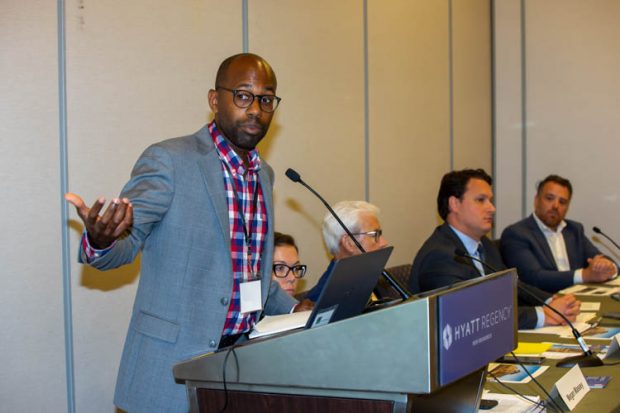
Christopher Brown, Director of Community Development, City of Hoboken, speaking during the 2023 NJ Planning & Redevelopment Conference. Photo by Frank H. Conlon
The three panelists from municipal governments highlighted components needed for the successful implementation of TOD. Morristown’s Dougherty insisted that planning must be prioritized during the process, imploring municipalities to “let the planners plan.” This means hiring independent professionals, not the elected official’s political appointees. Cilento, the Mayor of Dunellen, expressed the importance of community engagement. Public input is critical for transit-friendly planning; therefore, Dunellen conducts annual community surveys to inform the town on how community members feel about the current state and changes they wish to see going forward. Christopher Brown, of Hoboken, emphasized the importance of pedestrian design and safety. Hoboken’s zero traffic fatalities for 3 consecutive years is proof of the city’s continuous commitment to pedestrian safety. TOD cannot be successful without prioritizing pedestrians, nor is public transit accessible if it is surrounded by car-oriented development. Hence, Hoboken’s Hudson Place and Warrington Plaza are currently being redesigned to be more pedestrian-friendly like the rest of the city.
Christensen presented a few of NJ Transit’s current TOD projects. The Somerville station project is located on the Raritan Valley rail line. The development will have 512 residential units, including 356 apartments and 156 townhomes, and will provide community and open spaces, revitalize the station area, and enhance access to downtown Somerville. The Orange station project, located on the Morristown rail line, is a multi-phase residential development to build 410 apartment units in two phases. Additionally, the project will increase pedestrian safety, improve station access, and enhance community connections. The Metropark station project on the Northeast Corridor rail line will be home to a mixed-use development that includes 225 apartments, of which 20% of those apartments are affordable units. The Metropark mixed-use development will include a commercial office building and ground floor retail space. Importantly, the project makes station-area, circulation, offsite traffic mitigation, and pedestrian-friendly improvements to the area.
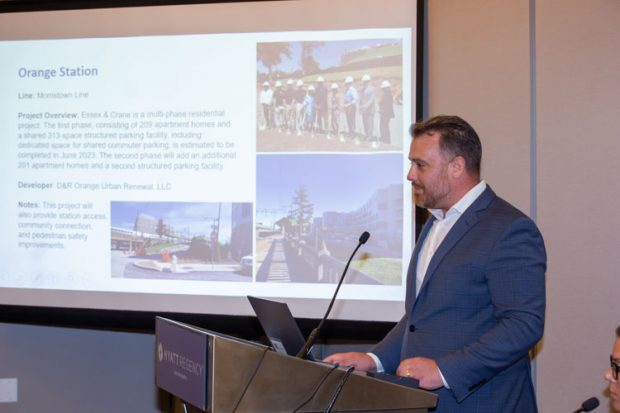
Owen Christensen, Project Manager, Transit Oriented Development, NJ TRANSIT, speaking during the 2023 NJ Planning & Redevelopment Conference. Photo by Frank H. Conlon
Transit friendly planning and TOD projects are vital for promoting equitable access throughout NJ. Folks who do not drive or own a car are unjustly excluded from many of society’s opportunities. Developing around transit centers improves the ability for community members to safely use public transportation to access critical needs, like employment opportunities and social services. The accessibility, equity, and safety benefits of TOD are evident, but they are not the only reasons for promoting transit-friendly planning. TOD is instrumental for addressing NJ Transit’s fiscal cliff as a means to build increased ridership through developing transit adjacent housing. As the need for TOD increases, demand for NJ Transit’s projects will increase too, presenting a unique opportunity for transit-oriented planning projects to improve the financial standing of NJ Transit. Therefore, TOD has the potential to benefit both municipalities and the state as a whole.
The Changing Faces of New Jersey Developers
July 18th, 2023 by Paula Figueroa-Vega

The Changing Faces of New Jersey Developers session at the 2023 NJ Planning & Redevelopment Conference. Photo by Frank H. Conlon
“Nationally, Black and Hispanic people are acutely underrepresented in real estate development…Black and Hispanic real estate developers represent less than 1% of their industry across the nation, even though Blacks make up 14% and Hispanics make up 18% of the total population. New Jersey’s affordable housing development space shows similar disparities. Between 2009 and 2023, of the 53 developers that received 9% low-income housing tax credit (LIHTC) awards in NJ, only three were Black or Hispanic-led/owned. Combined, they were awarded barely 3% of all the 9% LIHTC funding distributed in the past decade.1” These sobering statistics set the background for an engaging discussion during The Changing Faces of New Jersey Developers session at the 2023 New Jersey Planning and Redevelopment Conference, which featured four developers who have overcome challenges to shape and create their own paths in this field.
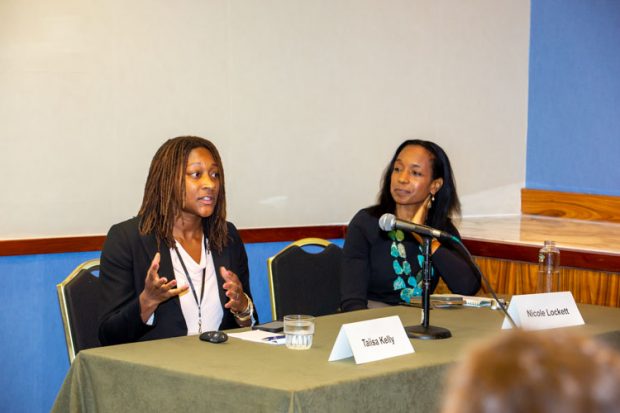
Taiisa Kelly, CEO of Monarch Housing Associates, speaking during the 2023 NJ Planning & Redevelopment Conference. Photo by Frank H. Conlon
The session was moderated by Taiisa Kelly, CEO of Monarch Housing Associates, and included affordable housing developers Adenah Bayoh, Founder and CEO of Foya Development; Eda Henries, Founder and Managing Principal of Henries & Co.; and Nicole Lockett, Managing Director of Development of Genesis Companies. They represent a rising generation of Black, Indigenous, and People of Color (BIPOC) leaders in housing and economic development who are creating a community to support each other.
The experienced developers grounded the panel in practical advice. All panelists have a successful track record of developments in New Jersey and are fighting together for individual opportunities to improve our communities: Lockett is one of those three aforementioned developers of color; Bayoh is heavily focused on affordable housing and restaurants; and Henries founded a capital advisory firm that serves small and medium-sized privately held companies. Finally, Kelly has experience in housing development, working with federal, state, and local funding sources to secure financing for special needs housing projects.

Eda Henries, Founder and Managing Principal of Henries & Co., speaking during the 2023 NJ Planning & Redevelopment Conference. Photo by Frank H. Conlon
The presenters’ journeys and reasons for becoming developers varied, reflecting numerous points of entry that were not motivated solely by business opportunities that exist in the housing market. Nicole Lockett’s journey began with volunteer work at the non-profit that her father was a board member of where she found a genuine passion toward the affordable housing industry and saw it as a way to assist people. Eda Henries, a registered broker brought into the field by Adenah Bayoh, explained that she was drawn to the financial aspects of the projects. Bayoh, on the other hand, grew up in affordable housing and views this work as an opportunity to create community spaces where people can gather. All expressed, in one way or another, that being a developer has provided an opportunity to create a new market, improve access, help people, diversify the leadership in the space, and build an ecosystem. They want to see others that look like them building more affordable housing. Lockett, who has years of experience in the business, explains that her motivation has evolved. While she still is “absolutely moved by residents” and recently opened a senior building, she comments that now, “I’m focused on growing developers.”
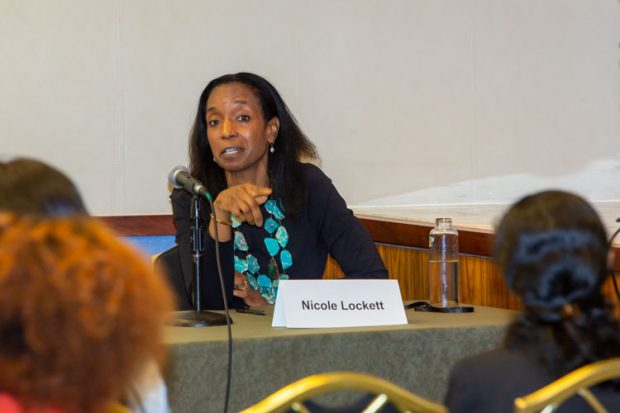
Nicole Lockett, Managing Director of Development of Genesis Companies, speaking during the 2023 NJ Planning & Redevelopment Conference. Photo by Frank H. Conlon
Lockett, who has years of experience in the business, explains that her motivation has evolved. “I’m focused on growing developers.”
Panelists discussed the role of policies and initiatives in incentivizing access to who gets to create affordable housing. “There is money in this space,” Lockett said. Laws and congressional acts support affordable housing initiatives, but the details are often hidden in lengthy bills. Advocacy is necessary to reduce the barriers embedded in regulations. The creation of rational policies depends on education and legislation. Unfortunately, some programs exclude the very people they are intended to help. Bayoh spoke about the need to focus on equity rather than equality when distributing public funds. The billion-dollar industry of affordable housing is heavily subsidized, making it crucial that tax money is distributed equitably, taking into consideration that not everyone has the same tools to compete.

Adenah Bayoh, Founder and CEO of Foya Development, speaking during the 2023 NJ Planning & Redevelopment Conference. Photo by Frank H. Conlon
One of the themes reiterated throughout the session was the importance of networks, especially for BIPOC developers. They suggested, “Get to know your mayor, the planner in your town, and know that there will always be opposition.” To effectively expand the development of affordable housing, it is crucial to be intentional. To do this, it is essential to build relationships. If you are interested in getting involved, the speakers suggest: “Start now.”
Bayoh closed the session by sharing a reflection and a call to action. She asked the packed room to imagine that instead of investing resources as the United States had done in the “war on drugs,” we directed that energy towards addressing the lack of affordable housing. Envision a “war on lack of affordable housing” and consider the possibilities of utilizing that energy to guarantee affordable housing for all.
__________________
1Data courtesy of the May 2023 Grove Impact report: Breaking the Glass Bottleneck: The Economic Potential Of Black And Hispanic Real Estate Developers And The Constraints They Face
Planning for Tomorrow, Not Today
July 18th, 2023 by Zeke Weston

The State of Planning and Redevelopment in New Jersey plenary at the 2023 NJ Planning and Redevelopment Conference. Photo by Frank H. Conlon
“It doesn’t matter if we make every vehicle electric, and it doesn’t matter if we turn of all power plants; climate change will still get worse,” exclaimed Shawn LaTourette, the Commissioner of the New Jersey Department of Environmental Protection (NJDEP), during the 2023 Planning and Redevelopment Conference plenary, The State of Planning and Redevelopment in New Jersey, co-sponsored by New Jersey Future and the NJ Chapter of the American Planning Association. In fact, each of the four plenary speakers identified climate resilience as an eminent issue facing the state. Coordinated resilience planning, along with a comprehensive energy master plan, sustainable economic development initiatives, and an update to the State Plan were offered as prominent solutions throughout the discussion.
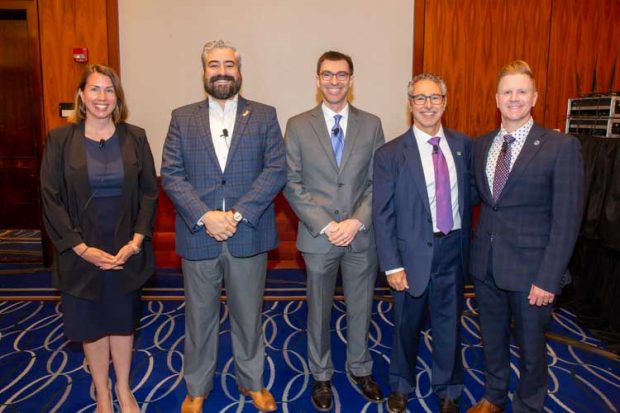
From left to right: Catherine Klinger, Executive Director, Governor’s Office of Climate Action and the Green Economy; Jorge Santos, Chief Real Estate Development Officer, New Jersey Economic Development Authority; Jeffrey Oakman, Senior Policy Advisor, Office of Governor Phil Murphy; Peter Kasabach, Executive Director, New Jersey Future; Shawn LaTourette, Commissioner, New Jersey Department of Environmental Protection. Photo by Frank H. Conlon
The plenary featured key state government executive branch officials from the Murphy Administration: Catherine Klinger, the Executive Director of the Governor’s Office of Climate Action and the Green Economy; Jeffrey Oakman, a Senior Policy Advisor in the Office of Governor Phil Murphy; Jorge Santos, the Chief Real Estate Development Officer for the New Jersey Economic Development Authority; and Shawn LaTourette, Commissioner of NJDEP. The plenary was moderated by Peter Kasabach, the Executive Director of New Jersey Future.
The purpose of NJ PACT is to update land use regulations to reflect the latest climate science to protect our state’s infrastructure from flooding.
NJDEP leads the climate change planning process in New Jersey, explained Commissioner LaTourette, and is one the region’s largest investors in climate resilience infrastructure. DEP’s statewide climate resilience strategy serves as a toolkit for agencies and municipalities to use when considering their own resilience approach. The most notable climate resilience action going forward will be a much needed update to the state’s climate and land use regulations, particularly regarding stormwater management and flood hazard rules. This regulatory reform effort is known as New Jersey Protecting Against Climate Threats (NJ PACT) and the first phase, the Inland Flood Protection (IFP) Rule, will be effective later this month. The data that informs current regulations for stormwater management and development in flood prone areas is outdated despite more frequent and intense storms and projected increases in rainfall. The purpose of NJ PACT is to update these land use regulations to reflect the latest climate science to protect our state’s infrastructure from flooding.
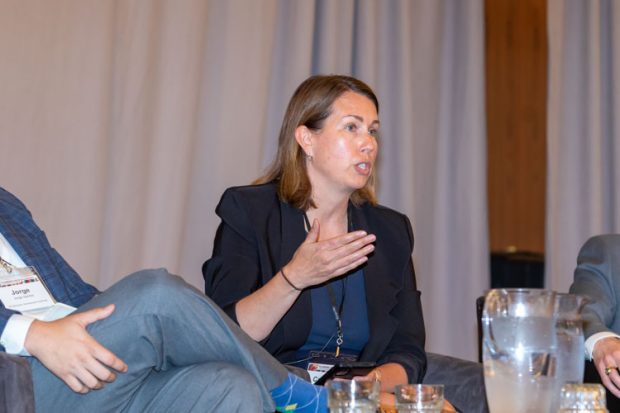
Catherine Klinger, the Executive Director of the Governor’s Office of Climate Action and the Green Economy speaking during the 2023 NJ Planning & Redevelopment Conference. Photo by Frank H. Conlon
Catherine Klinger explained how clean energy is crucial to the existence and health of New Jersey’s communities heading into the future. A comprehensive energy master plan that includes clean building guidance, climate pollution reduction strategies, and anticipated costs is vital to the state’s sustainability. The 2019 energy master plan was due to be updated in 2022, but because of numerous industry advancements, the state revised the schedule. The 2024 energy master plan will include updated data, new innovations, and anticipated costs. In addition to the statewide plan, Klinger noted that municipalities have the opportunity to develop clean energy infrastructure on their own in order to benefit their residents. Such infrastructure includes community solar arrays, public EV charging stations, thermal heat networks, and decarbonized vehicle fleets.

Jorge Santos, the Chief Real Estate Development Officer for the New Jersey Economic Development Authority, speaking during the 2023 NJ Planning & Redevelopment Conference. Photo by Frank H. Conlon
Jorge Santos detailed the significance of economic development initiatives for a sustainable New Jersey. The various economic development programs serve to improve planning and redevelopment processes and outcomes in the state. For instance, the new Stranded Assets Investment Program will help communities reposition unused assets like vacant office buildings and strip malls. This program is just one of over fifty active EDA programs, and the agency anticipates more programs to come. Through these programs, Santos explained how the EDA strives to create jobs and enhance economic activity where it is needed, while also improving diversity, equity, and inclusion.

Shawn LaTourette, Commissioner, NJDEP, speaking during the 2023 NJ Planning and Redevelopment Conference. Photo by Frank H. Conlon
The State Plan “serves as the connective tissue across state government in implementation.” – Commissioner Shawn LaTourette, NJDEP.
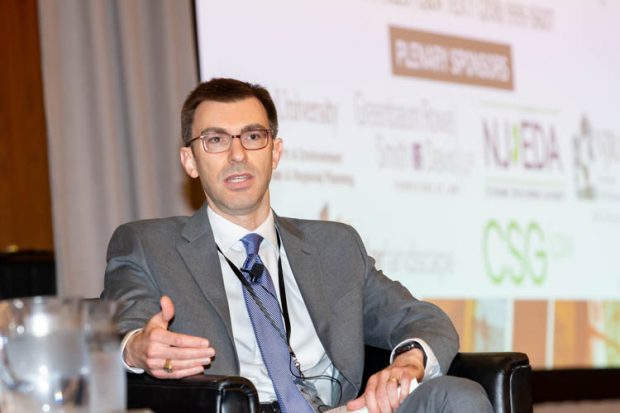
Jeffrey Oakman, a Senior Policy Advisor in the Office of Governor Phil Murphy, speaking during the 2023 NJ Planning & Redevelopment Conference. Photo by Frank H. Conlon
The panel unanimously agreed upon the need to update the State Plan. “I think we can all agree in this room that the state plan from 2001 is well overdue for an update,” Jeffrey Oakman joked while referring to the absence of climate change and equity considerations in the plan. Despite its age, the twenty-two year old document contains an abundance of important and useful information including guidance on center-based development, urban revitalization, and farmland preservation. Santos explained how the Economic Development Authority actively refers to the 2001 State Plan as a guide when developing and implementing its programs. Santos noted that updating the plan to be more relevant would be immensely helpful to the agency. For the update to be effective, Oakman suggested that it include environmental justice, economic justice, climate adaptation and resilience, and racial equity. Oakman also recognized the importance of improving the accessibility of the plan; making the document accessible online with user-friendly tools is vital for helping agencies and localities implement the plan’s priorities. The State Plan “serves as the connective tissue across state government in implementation,” stated LaTourette; therefore, ensuring that folks can easily engage with it and understand it is a critical component of the update process.
The importance of sensible and equitable planning and redevelopment is directly correlated with fostering healthy and resilient communities. For New Jersey, this means developing coordinated climate resilience planning, a comprehensive energy master plan, sustainable economic development initiatives, and a much needed update to the State Plan. The plenary, The State of Planning and Redevelopment in New Jersey, concluded with a multitude of questions from the audience. PRC attendees were eager for the panel to hear their questions, and the panelists were ready for whatever the audience threw at them. The energetic ending to a productive session, ignited synergy for further discussions on planning issues in New Jersey. For further reading on the importance of an updated state plan for NJ, please read “Launching the Next State Plan”, which explored this topic at a breakout session at the conference.
Hinchliffe Stadium Opens New Opportunities for Paterson while Reconnecting to its Past
July 18th, 2023 by Michael Atkins

The restoration of Hinchliffe Stadium in Paterson, NJ.
While New York City boasts the “House that Ruth Built,” and Cooperstown and Kansas City host hall of fames, New Jersey’s role in the history of baseball, and in particular, NJ’s open exhibition of Black baseball during segregation is often overlooked. Hinchliffe Stadium was once a bustling hub for Black baseball, drawing fans from across the region to Paterson, NJ to see the best players of the day. After years being unoccupied, a new and exciting redevelopment project in Paterson — the largest historic preservation project in NJ — that is the talk of the town and state, providing an unmatched example for blending outdoor activities, historical representation, and contemporary urban needs in one mixed-use project.
A session at the Planning and Redevelopment Conference dedicated to chronicling the success of the Hinchliffe redevelopment project titled, “Thrills, Skill, & Spills: Lessons Learned from the Hinchliffe Stadium/Paterson Redevelopment Project” convening public and private perspectives on this stellar project that has energized local and statewide communities. Panelists included Baye Adofo-Wilson, Redevelopment Counsel, Post Polak; Joseph Portelli, Senior VP of Development, RPM Development Group; Michael Powell, Director of Economic Development, City of Paterson; and George Wheatle Williams, Founding Principal, Nishuane Group, LLC; and was moderated by Anne Babineau, Shareholder, Wilentz, Goldman & Spitzer, P.A.
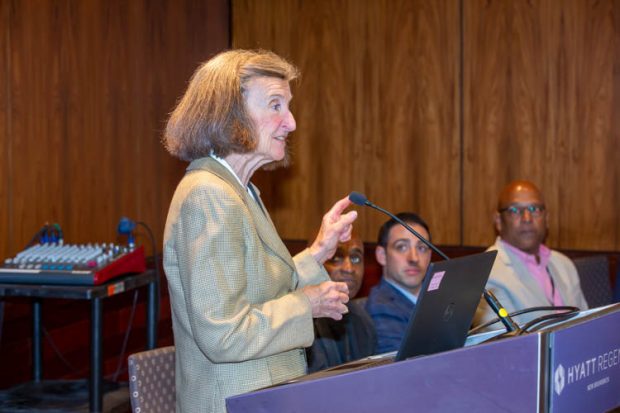
Anne Babineau, Shareholder, Wilentz, Goldman & Spitzer, P.A., speaking during Thrills, Skill, & Spills: Lessons Learned from the Hinchliffe Stadium/Paterson Redevelopment Project session at the 2023 NJ Planning & Redevelopment Conference. Photo by Frank H. Conlon
In summary, the project provides the following amenities: revitalization of the stadium to include recreational facilities for local school, a museum dedicated to Negro League Baseball, development of 75 new affordable units for seniors, and a 315 space parking facility. Joseph Portelli, who brought with him a presentation featuring photographs, renderings, and a drone film overview of the site, noted the 800-seat stadium will also host a restaurant and a daycare.
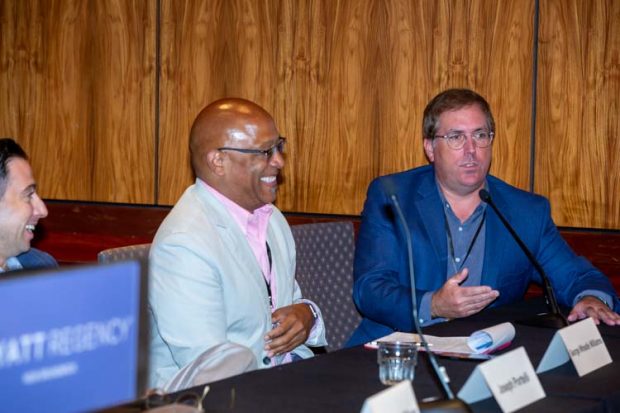
Michael Powell, Director of Economic Development, City of Paterson, speaking during the 2023 NJ Planning & Redevelopment Conference. From left to right: Joseph Portelli, Senior VP of Development, RPM Development Group; George Wheatle Williams, Founding Principal, Nishuane Group, LLC; Michael Powell, Director of Economic Development, City of Paterson. Photo by Frank H. Conlon
“The point is difficult things are difficult to do, but it takes a good team to get it done.” -Michael Powell, City of Paterson
The assembled panelists, all of whom worked closely on various aspects of the redevelopment project, shared how blending and balancing community needs with funding streams made it possible. Each component of the project had a funding source, and a discreet use. While it is in total a mixed use project, each “use” had a dedicated funding stream including, but not limited to, historic and new market tax credits, soft subsidies, and Covid recovery funds.
This varied approach in securing funding mirrored the complexities of stakeholders in the project. Hinchliffe Stadium is a city property owned by the Paterson School Board and is a National Historic Landmark site, with each layer posing challenges. “In negotiating with the school board, your threshold for community partnerships is a real challenge. You need to at times bite the bullet for the common good,” noted Adofo-Wilson. With the school district serving as the primary tenant for 180 days of the year, the project team had to continually persuade external partners of the ultimate positive impact the project would have on the city and community.
“Paterson is the third largest city in New Jersey. Cities needed a certain amount of push. Paterson is [oriented] around the Falls, and densely populated [with] 168,000 people,” explained Baye Adofo-Wilson. He asks, “How do you maximize the people, how do you maximize the historic assets, and how do you think about towns that are fundamentally oriented differently than ‘How fast can you get me to New York or Philadelphia?’”

Baye Adofo-Wilson, Redevelopment Counsel, Post Polak, speaking during the 2023 NJ Planning & Redevelopment Conference. From left to right: Baye Adofo-Wilson, Redevelopment Counsel, Post Polak; Joseph Portelli, Senior VP of Development, RPM Development Group. Photo by Frank H. Conlon
Global, national, and statewide trends all influenced the realization of this project in the heart of Paterson. As Michael Powell shared, “The realities of dealing with this during Covid was that what made this project possible is because it was outdoors, and because the museum examined race and class history in America. To do this around a narrative that makes Paterson interesting as a minority-majority city, is that it hasn’t gotten its fair shake.” Adofo-Wilson added to this, “NJ has a great policy that mandates Black History education in NJ. This is a new policy and a new opportunity. We have created a regional and statewide attraction to bring NJ students to a Black history site.”
Wheatle Williams, noted that the story begins much earlier than 2020, or the current elected administration taking office in 2018. It all starts with thoughtful planning. “I would like to acknowledge Paterson’s role and give credit to the work done on the planning and public side. Their 2003 Master Plan spoke to using redevelopment planning in Paterson strategically and intentionally. When the Master Plan was updated in 2014, it again focused on redevelopment plans for Paterson, including Hinchliffe Stadium.”
Adofo-Wilson reflected, “Everybody feels like they own the stadium. We had an 80 something couple who were a cheerleader and running back with memories from the stadium stretching back to the 1950s. And we had a number of people involved in this project who went beyond their professional obligations over and over again out of dedication to making this project a reality.” Powell concurred, “The point is difficult things are difficult to do, but it takes a good team to get it done.” With Hinchliffe Stadium now once again playing host to baseball, Paterson has many fans locally and statewide cheering it on from the stands.
Launching the Next State Plan
July 18th, 2023 by Zeke Weston
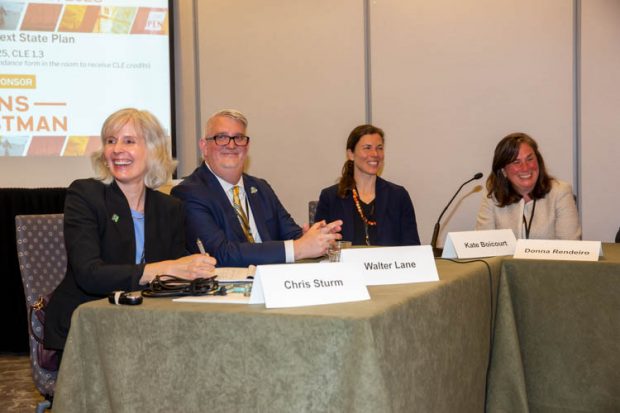
Launching the Next State Plan session at the 2023 NJ Planning and Redevelopment Conference. From left to right: Chris Sturm, Policy Director, Land Use, New Jersey Future; Walter Lane, Director, Somerset County Office of Planning Policy & Economic Development; Kate Boicourt, Director, Climate Resilient Coasts and Watersheds, New York – New Jersey, Environmental Defense Fund; Donna Rendeiro, Executive Director, New Jersey Office of Planning Advocacy. Photo by Frank H. Conlon
The State Plan “is more than a guide for land-use… it’s for public health, transportation, and much more,” stated Michael Kolber, Senior Planner for the City of Trenton, during the 2023 Planning and Redevelopment Conference as a panelist on the roundtable session Launching the Next State Plan, sponsored by New Jersey Future and the New Jersey Chapter of the American Planning Association. Despite its immense importance as a guide for the state’s future growth, New Jersey’s State Development and Redevelopment Plan has not been updated since 2001. From the demographics to geography, a lot has changed over 22 years. Launching the Next State Plan explored how to best update the State Plan to better reflect the present conditions and future outlook of New Jersey.

Launching the Next State Plan session at the 2023 NJ Planning and Redevelopment Conference. State Planning Commission members in attendance included Tom Wright, Edward McKenna, Elizabeth Terenik, Stephen Santola, Bruce Harris, and Danielle Esser. Photo by Frank H. Conlon
At this standing room only session, State Planning Commissioners and session panelists outlined the opportunities provided by the first State Plan update in two decades, and engaged in a dynamic back and forth, propelling momentum for further discussions. Donna Rendeiro, Executive Director of the New Jersey Office of Planning Advocacy, and Peter Kasabach, Executive Director of New Jersey Future, served as the session’s moderators, overseeing the convening of State Planning Commission members and interested stakeholders. The panel sought to answer the following three essential questions: First, if the State Plan update is successful, what would be different in New Jersey? Second, how should the updated Plan differ from the current one? Third, how can the Plan be implemented to ensure good land use outcomes? Tom Wright, Chair of the Commission, kicked off the session by articulating the importance of the State Plan as both a policy framework and a forum for balancing planning issues. When the State Plan was last updated in 2001, it was designed to direct growth, development, and preservation decision-making, but it had almost no consideration for climate change or equity. Emphasizing and strengthening the planning and implementation processes of the State Plan are crucial to its success.

The audience engaging in launching the next state plan at the 2023 NJ Planning & Redevelopment Conference. Photo by Frank H. Conlon
Panelists recommended specific ways to address the issue of climate change in the State Plan. Walter Lane, the Director of the Somerset County Office of Planning Policy and Economic Development, explained the need to protect communities from rising sea levels, higher precipitation rates, frequent flooding, and repeated storms by incorporating climate-resilient land-use policies, transportation systems, and economies into the State Plan. Chris Sturm, Policy Director for Land Use at New Jersey Future, explained the significance of incorporating a geographic framework for climate change adaptation planning so that communities can plan earlier rather than later. Sturm suggested that the updated State Plan could designate the coastal region as a Special Resource Area and lay the groundwork for future designation of highly-developed areas that should be fortified, areas where retreat is inevitable, and areas in-between. Including climate change related goals and metrics offers a unique opportunity to bring together and utilize up-to-date data in order to establish measurable targets, explained Kate Boicourt, the Director of Climate Resilient Coasts and Watersheds in New York and New Jersey for the Environmental Defense Fund.
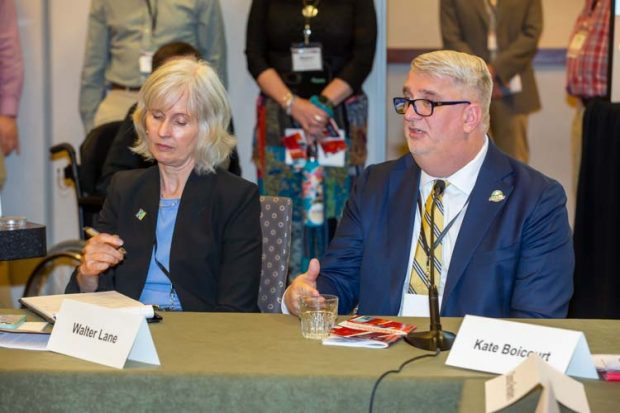
Walter Lane, the Director of the Somerset County Office of Planning Policy and Economic Development, speaking during the 2023 NJ Planning & Redevelopment Conference. Photo by Frank H. Conlon
Incorporating equity as a central tenet of the updated State Plan will ensure its ultimate effectiveness in improving the lives of all New Jerseyans.
The national emphasis on inclusivity and equity among government, corporations, and nonprofits provides New Jersey the opportunity to incorporate equity as a central tenet of the updated State Plan to ensure its ultimate effectiveness in improving the lives of all New Jerseyans. In particular, a concerted effort to include environmental justice in planning is overdue. This is especially true in NJ, given our state’s history of overlooking the interests of those who are most vulnerable. Kandyce Perry, the Director of the Office of Environmental Justice in the New Jersey Department of Environmental Protection, made it clear that New Jersey’s overburdened communities need to be explicitly protected from over concentrations of pollution and its effects. She identified the monumental importance of infusing environmental justice and equity into the updated State Plan. Because of the history and demographics of our state, Michael Kolber, the Senior Planner for the City of Trenton, explained that the best way to address environmental justice is through cross-municipality and regional planning. Along with climate vulnerability and concentrated pollution, New Jersey’s equity issues include housing affordability. George Vallone, the Founder and President of the Hoboken Brownstone Company, expressed concern about the lack of housing supply in the state, observing that statewide roughly 18,000 homes were for sale in May 2022, whereas only 13,000 homes were for sale by May 2023. Vallone urged the updated State Plan to make it easier and faster for housing to get built. Doing so will decrease housing costs and increase housing supply, thus reducing demand on limited housing supply and contributing to more affordable communities.

From left to right: George Vallone, Founder & President, Hoboken Brownstone Company; Kandyce Perry, Director of the Office of Environmental Justice in the New Jersey Department of Environmental Protection; Janice Kovach, Mayor, Town of Clinton during the 2023 NJ Planning & Redevelopment Conference. Photo by Frank H. Conlon
“Mayors need to be at the table and not on the menu.” Janice Kovach, Mayor of the Town of Clinton.
For a successful State Plan update, “mayors need to be at the table and not on the menu,” Janice Kovach, the Mayor of the Town of Clinton, cautioned. Kovach continued to highlight the importance of communication and coordination between state agencies and municipalities, so that all levels of government are on the same page. Boicourt agreed that there must be a two-way dialogue between municipalities and the state during the planning process. Lane suggested that Counties can play a more prominent role between the state and municipalities, explaining that counties should be more than negotiating entities for the State Plan since they are equipped to provide assistance to local communities and develop regional plans, like Somerset County’s Investment Framework. Panelists also stressed the importance of the implementation process. Gil Medina, the Executive Vice President of CBRE, insisted that the process starts and ends with the governor’s leadership. He explained that State Planning is not a partisan issue, thus every governor should understand its importance; the governor and their cabinet must be committed to implementing the updated State Plan in order for everyone else to follow suit, otherwise the process will fail.
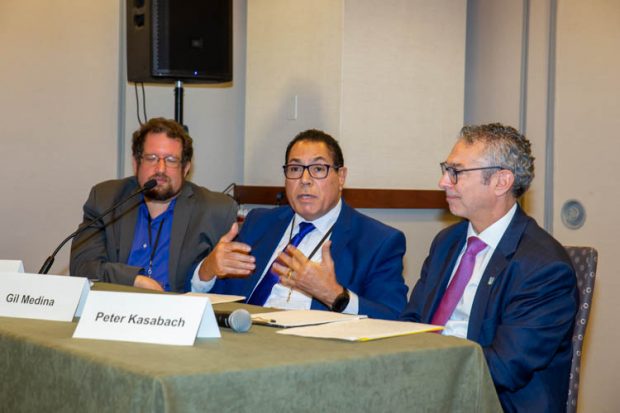
Gil Medina, Executive Vice President, CBRE, speaking during the 2023 NJ Planning & Redevelopment Conference. From left to right: Michael Kolber, Senior Planner, City of Trenton; Gil Medina, Executive Vice President, CBRE; Peter Kasabach, Executive Director, New Jersey Future. Photo by Frank H. Conlon
The 2023 Planning and Redevelopment Conference session, Launching the Next State Plan, provided a forum for how to best update the State Plan. Incorporating climate change and equity will be immensely influential to the effectiveness and relevance of the State Plan, but so is addressing key issues regarding its structure, what it can accomplish, who will participate, and how they will participate. As this crucial planning process begins it is critical for public engagement and input; therefore Donna Reindeiro of the New Jersey Office of Planning Advocacy welcomes you to submit your comments (Stateplan comments
comments sos
sos nj
nj gov) .
gov) .
Examining the Influence of 50 years of Hip Hop on Planning and Redevelopment
July 18th, 2023 by Michael Atkins
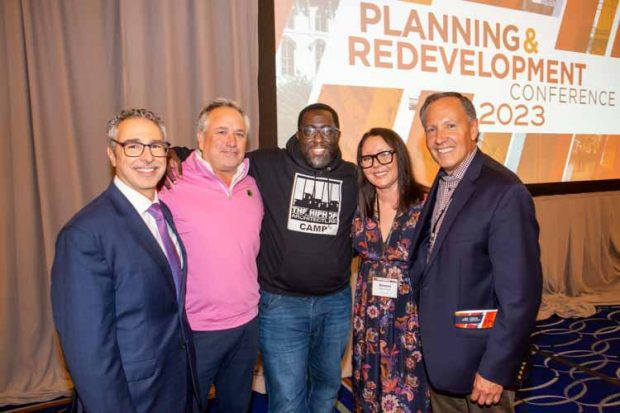
From left to right: Peter Kasabach, Executive Director, New Jersey Future; Charles Latini, President, American Planning Association – NJ Chapter; Michael Ford, Founder, BrandNu Design Studio; Sheena Collum, Executive Director, American Planning Association – NJ Chapter; Thomas Dallessio, Vice President of Policy, American Planning Association – NJ Chapter . Photo by Frank H. Conlon
On the occasion of hip hop’s 50th birthday, media companies, nonprofits, and the general public are charting the massive influence of this musical and cultural phenomenon on all aspects of modern life. This was no different at the 2023 Planning and Redevelopment Conference, co-hosted by New Jersey Future and the American Planning Association NJ Chapter, where two sessions addressed hip hop and its intersection with planning and architecture.
As the keynote speaker at the conference’s third and final day, Mike Ford captivated the audience by sharing his perspective and life experience as a hip hop architect. Ford began by reaching back a century ago to tell the story of Black influence on architecture, pointing to an infamous, albeit problematic, rendezvous between jazz great Josephine Baker and her unrequited and unscrupulous admirer, Le Courbusier. “Jazz is more advanced than architecture…if architecture were at the point reached by jazz, it would be an incredible spectacle,” Le Corbusier observed in the height of his obsession with Baker, whom he met on a cruise while the singer was a major performer in 1920s Paris. To mark this chance encounter that altered the trajectories of both music and architecture, Ford led the attendees through a sing-a-long rendition of Biz Markie’s “Just a Friend”.
Ford then launched into a pointed but popular criticism of modern planning and design, pointing to the massive attention paid in today’s society to conduct proper, inclusive outreach across racial lines, while hip hop as an art form has chronicled the history of dispossession, economic exclusion, and the built environment throughout its entire history. “As design professionals, if we can listen to the words of hip hop artists, then we can listen and see the criticisms they have been raising for 50 years and counting.”
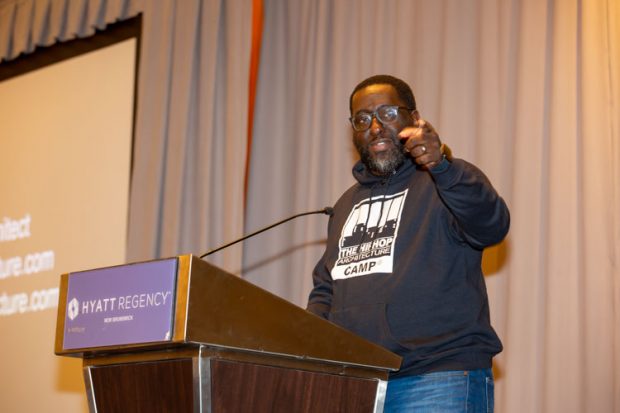
Michael Ford, Founder, BrandNu Design Studio, speaking during the 2023 NJ Planning and Redevelopment Conference. Photo by Frank H. Conlon
“Hip Hop is a reflection of the built environment.” – Mike Ford
Ford recounted his various endeavors working with youth cohorts to address the built environment. Hip Hop Architecture Camp introduces young people to architecture through a culturally relevant pedagogy. Young people deconstruct the lyrics and complexity of hip hop’s rhythm, texture and patterns, construct 3D models, often their first exposure to forming these types of models, of cities to reflect the lyrics of a given hip hop song and compare lyricists, and write their own original rhymes. Ford uses hip hop as a point of access to civic and racial history to engage, for instance, Detroit youth and the history of displacement and segregation through highway infrastructure development.
Ford has participated in a variety of projects throughout North America that have blended hip hop sensibilities into contemporary urban needs. A prominent example being the Universal Hip Hop Museum (Bronx, NY), a mixed use building with the bottom two floors providing space for the museum and a housing complex boasting 526 affordable units above. Ford is also involved in the highly anticipated Black Inventors Hall of Fame, coming to Newark, NJ, to honor the history of their contributions to American history. According to the project’s website, “The museum is envisioned to be a 31,000 sq ft. facility with state of the art, tuition free STEAM classrooms, theater, Metaverse library, startup incubator, and a Legends Hall featuring the top Black inventors of the Golden Era in this country.” As to why these stories must be told through a museum, “Because when you build public spaces, it matters.”
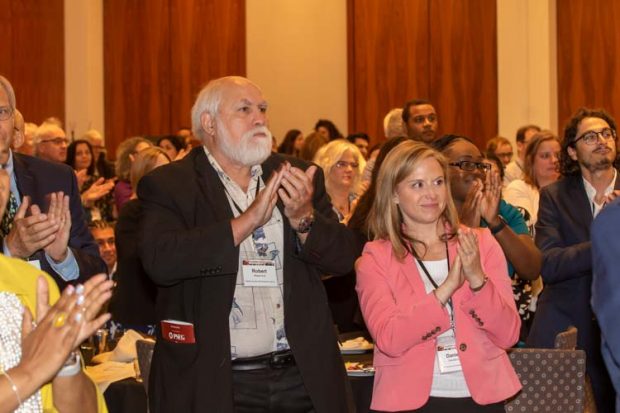
Standing ovation after Michael Ford’s keynote, Hip Hop Beyond Beats and Rhymes, Architecture Beyond Bricks and Mortar, at the 2023 NJ Planning and Redevelopment Conference. Photo by Frank H. Conlon
In conclusion, Mike Ford provided the following closing remarks to a standing ovation: “Hip Hop architecture is not just an idea or academic pursuit. It’s not just whimsical and fun and making curvy [stuff] because it has to be tied to hip hop. To me hip hop sustains life. When you can combine hip hop, architects, and designers, we can do some amazing things. Teaming hip hop artists with humanitarian projects can accomplish great things.”
A second session at the Planning and Redevelopment Conference dedicated to exploring the influence of hip hop was titled, “Hip Hop Will Save Your Life”, featuring speakers LaTricea Adams, Founder CEO & President, Black Millennials 4 Flint; Russell Armstrong, Climate and Environment Policy Director, Hip Hop Caucus; Darren Harris, Founder and CEO, PANN TV; and moderated by Tomas Varela, Executive Director, New Jersey Black Empowerment Coalition.

How Hip Hop Will Save Our Life virtual session at the 2023 NJ Planning and Redevelopment Conference. Top row from left to right: Tomas Varela, Executive Director, New Jersey Black Empowerment Coalition; LaTricea Adams, Founder CEO & President, Black Millennials 4 Flint. Bottom row from left to right: Russell Armstrong, Climate and Environment Policy Director, Hip Hop Caucus; Darren Harris, Founder and CEO, PANN TV.
Adams explained why the Flint Water Crisis resonated so deeply and broadly with Black culture and the hip hop community, stating, “While the issue began in 2014, it wasn’t until a year later that most of American became aware of the crisis.” Suspicions among local community members that their majority Black city wasn’t being told the truth about their water supply raised long-standing concerns that challenged the perceived social progress in America, begging the question: Why are we still fighting for the most basic of civil rights?
The Hip Hop Caucus was formed a full decade before the Flint Water Crisis, at that time primarily addressing voting rights before quickly expanding into intersectional issues around environmental and economic justice in the wake of Hurricane Katrina’s devastation, which disproportionately impacted Black communities in the South. On the subject of integrating artists into public campaigns, Armstong noted that artists have to live off of their own fame, but want to speak on issues they care about, whether it be a local water issue or fundraising for relief in the aftermath of a hurricane. Armstrong stated, “Outside of Jackson and Flint, we had a water crisis in NJ. These are issues that the Black community has known about for a long time before the mainstream media picks up on these issues. The same issues we are talking about are the same ones that hip hop artists are passionate about. As the Hip Hop Caucus, we respect that.”
“Nothing wrong bringing the culture into advocacy. Everyone can be involved.” –Russell Armstrong, Hip Hop Caucus
Harris, for his part, has founded and operates a media platform with exactly that capacity. Harris recounted the growth of his online media platform, PANN TV, and their approach of crowdsourcing material pertinent to their audience. He pointed to two prominent examples of the influence of hip hop, both near and far. “At this point hip hop is not just the music, it’s how we look, how we speak, the way we look when we walk into a room. The Mayor of Newark, Ras Baraka, is a representative of the hip hop community…and diaspora.” Harris continued by pointing to the life and legacy of Nipsey Hussel, who, before his murder, was an influential figure in both the musical and his local communities. Hussel was a local icon in South Los Angeles, where he bought real estate, opened businesses and resource centers for youth. Before his death, he took an active role in planning and advising “Destination Crenshaw”, a public private partnership between the city, county metro, and private business to open a mile long open-air celebration of Black Culture in LA along Crenshaw Boulevard, LA’s historic Black commerce district, in conjunction with the expansion of metro service to the airport and newly constructed professional football stadium.
In their concluding remarks, Adams and Harris both encouraged attendees to value artists and Black media in shaping public goods, services, and spaces. Armstrong concurred, advising, “Nothing wrong bringing the culture into advocacy. Everyone can be involved. Every different generation can engage in this work. Folks want to bring their full selves into the work they are doing on a day to day basis.”
Common Ground Emerges on Affordable Housing Solutions
July 17th, 2023 by Chris Sturm
“New Jersey has a storied history of working to address affordable housing. For over five decades, municipalities and developers have collaborated and/or clashed in state agencies and in the courts,“ noted Tom D’Allessio, Vice President of Policy, American Planning Association, NJ Chapter, as he opened one of the two lively, productive sessions on affordable housing at the 2023 Planning and Redevelopment Conference. The panelists on these sessions, representing municipal and state officials, housing advocates, planners, and developers at times clashed. Their disagreements, always respectful, included opposing views on the state mandate to build affordable housing in affluent communities, the value of a court-supervised process, the ability of regional planning to facilitate development, and the root causes of local opposition.
Despite diverging perspectives, the speakers found broad consensus on key aspects of affordable housing, including the growing need, remarkable progress, unproductive litigiousness, and the importance of addressing long-standing impediments. A panel titled, Fourth Round Obligations: For Whom? By Whom?, addressed the process by which affordable housing is planned and built pursuant to legal requirements under the Mt. Laurel doctrine. A second panel, Confronting New Jersey’s Housing Affordability Crisis, focused on removing obstacles to developing housing that is affordable to both low- and moderate-income families and also the “missing middle”. New Jersey Future and the New Jersey Chapter of the American Planning Association sponsored the conference.

The panel during the 2023 NJ Planning and Redevelopment Conference virtual session Fourth Round Obligations: For Whom? By Whom? Top row from left to right: Josh Bauers, Senior Staff Attorney, Fair Share Housing Center; Elizabeth McManus, Co-founder, Kyle + McManus Associates, LLC; Jeff Kolakowski, Chief Executive Officer, New Jersey Builders Association. Bottom row from left to right: Paul Muir, Mayor, Bethlehem Township; Ben Spinelli, Executive Director, New Jersey Highlands Council; Thomas Dallessio, Vice President of Policy, American Planning Association – NJ Chapter.
Opportunities for moving forward in the Mt. Laurel Fourth Round. Panelists in the session, Fourth Round Obligations: For Whom? By Whom?, focused on the phase beginning July 1, 2025. Josh Bauers, Senior Staff Attorney, Fair Share Housing Center, listed successes achieved during the past eight years of the Mount Laurel process: more towns (345) have court settlements in place, and 22,000 units of housing affordable to low- and moderate-income households have been built. Paul Muir, mayor of Bethlehem Township and president of the NJ Conference of Mayors, shared his hope for a regional planning approach overseen by a state agency that limits housing obligations based on available support services. Ben Spinelli, executive director of the New Jersey Highlands Council, also argued for a regional approach consistent with the Highlands Regional Master Plan to ensure protection of the drinking water supply. “But where will we grow as a state?” asked Jeff Kokakowski, chief executive officer, New Jersey Builders Association, in the face of limited vacant land and many regulatory requirements. Beth McManus, co-founder, Kyle + McManus Associates, LLC, cautioned that regional planning works well for preservation but makes it “harder to get to growth.”
The speakers found common ground on the need to make the planning and development process more efficient in the Fourth Round. Speakers urged communities to start planning now and quickly reach agreement on housing requirements so, as Ben Spinelli said, “we can spend the time building.”
Panelists recommended that state agencies:
- Coordinate permitting issues across agencies and ensure that road, sewer, water, and transit capacity are available to make development in good locations as easy as possible. (Spinelli and McManus)
- Provide clear direction on where compact development can occur, given multiple, sometimes inconsistent, state regulations. (Kolakowski)
- Determine municipal obligations well in advance of the July 2025 deadline to make it easier and cheaper to get through the settlement process. (McManus)
- Revise regulations to ensure that affordable units are properly integrated into inclusionary projects and are built to similar sizes and standards as market rate units. (McManus)
Panelists recommended that municipal officials:
- Identify areas appropriate for higher density development, which are supported by services, schools, and public facilities. (McManus)
- Lay the groundwork for growth by explaining how it can be positive for the community. (McManus)
- Cooperate with, rather than litigate, the process, and build on experience from the third round. (Bauer)
- Learn how to use the redevelopment statutes and accompanying tools. (Bauer)
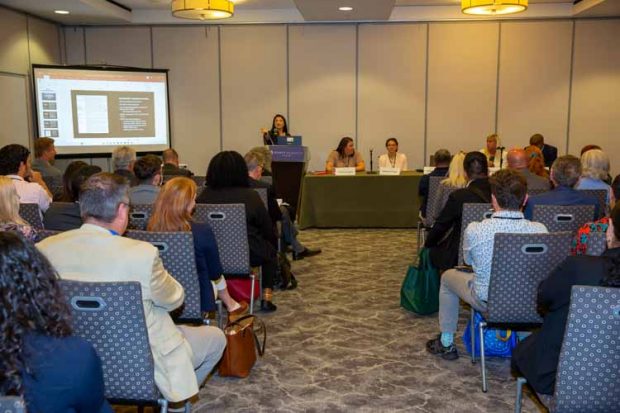
The Confronting New Jersey’s Housing Affordability Crisis session at the 2023 NJ Planning and Redevelopment Conference. Photo by Frank H. Conlon
The framework for providing low, moderate and middle-income housing. Jong Sook Nee, member, Convergent Law, kicked off Confronting New Jersey’s Housing Affordability Crisis with statistics illustrating the extent of the problem. For example, she noted that only 21% of for-sale homes are considered “affordable,” and Northern New Jersey ranks as the nation’s most competitive rental market. Jong outlined many approaches for providing affordable housing including municipal housing authorities, privately owned and operated housing, and the Mount Laurel process, as well as the use of subsidy tools including Low Income Housing Tax Credits, municipal Payments in Lieu of Taxes, and state incentive programs.

Jong Sook Nee, Member, Convergent Law, speaking during the 2023 NJ Planning and Redevelopment Conference. Photo by Frank H. Conlon
Key challenges: zoning and development process. The four panelists in this session fell into two groups when asked to identify the greatest challenges facing housing affordability. Lorissa Luciani, administrator of affordable housing at the NJ Department of Community Affairs, and Katherine Payne, director of land use, Fair Share Housing Center, cited zoning constraints, including the need for more multi-family zoning and opportunities for dense redevelopment. The panel’s two developers highlighted the importance of the development process. “Process is the hurdle to supply,” noted Deb Tantleff, founding principal of Tantum Real Estate. Patrick Teborg, founder, TD+ Partners, described the benefits of working with “a process-driven municipality” like Plainfield where win-win solutions can be found relatively quickly when the city and the developer employ a “problem-solving” approach. Teborg noted the difficulty of working in affluent municipalities that seek to obstruct affordable housing.
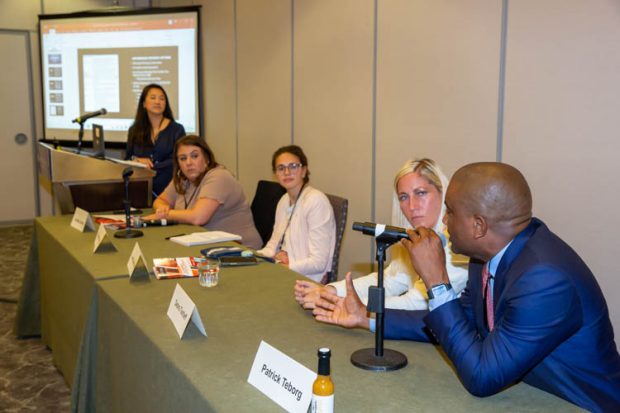
Patrick Terborg, Founder, TD+ Partners, speaking during the 2023 NJ Planning and Redevelopment Conference. Photo by Frank H. Conlon
Actionable recommendations. As with the other housing session, panelists offered actionable recommendations for increasing the supply of housing that is affordable.
Panelists recommended that state agencies:
- Provide a standardized checklist for site plan submission and clarity on buildable locations especially near flood zones. (Deb Tantleff)
- The NJ Housing Mortgage Finance Agency should reform its Low Income Housing Tax Credit program to allow broader participation, including by market-rate developers. (Teborg)
- The Department of Community Affairs (DCA) should dramatically revamp parking requirements in the Residential Site Improvement Standards (Tantleff).
- Ensure, through the Mount Laurel process, that all communities are accessible to people with lower incomes, including those with good schools and other amenities. (Payne)
Panelists recommended that municipal officials:
- Explore newly-funded DCA subsidy programs, which may grant waivers to address record-high per unit construction costs. (Luciani)
- Work with Mount Laurel Fourth Round process, in recognition of the Third Round’s “incredible productivity” at producing multi-family and affordable housing units. (Payne)
- Streamline the process to reduce the time to construction, learn about real estate finance, and loosen zoning restrictions that prevent the kinds of units that consumers want. (Tantleff)
- Provide a transparent, respectful process for developers. (Teborg)
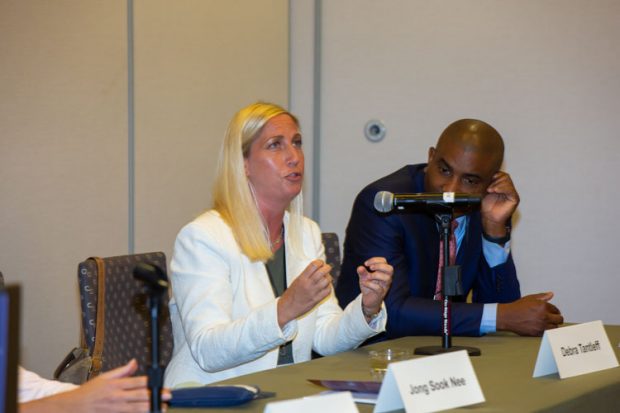
Debra Tantleff, Founding Principal, Tantum Real Estate, speaking during the 2023 NJ Planning and Redevelopment Conference. Photo by Frank H. Conlon
Multi-family housing— the market, the opposition, the constraints. An animated discussion period offered opportunities for panelists and attendees alike to explore the root causes of local opposition to multi-family and affordable housing: racism, fear of density, and “change,” including more traffic and loss of green space. Deb Tantliff recommended local officials focus the conversation on people—in addition to the well-documented demand for compact housing by the under 35 crowd, current residents may want to stay in town and live in more compact units, especially in-town aging baby boomers and recently-divorced parents. The developers noted that “missing middle” or “workforce” housing is hard to build given high fixed costs, especially in affluent communities, and that deed-restricted units for households earning between 80% and 120% of the median may be unable to get financing.
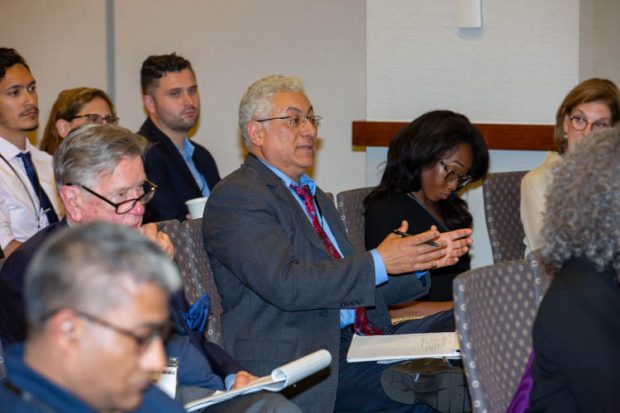
Discussion with the audience during the Confronting New Jersey’s Housing Affordability Crisis session at the 2023 NJ Planning and Redevelopment Conference. Photo by Frank H. Conlon
Housing affordability lies at the heart of New Jersey Future’s commitment to creating strong, healthy, resilient communities for everyone. The Planning and Redevelopment Conference provided an important opportunity for tackling the issue, including two additional sessions on the topic that are not covered here: Resilient and Affordable: Planning for Your Affordable Housing Obligation in the Era of Climate Change and The Changing Faces of New Jersey Developers. Both conference sponsors, New Jersey Future and the New Jersey Chapter of the American Planning Association, plan to hold additional forums to identify ways to ensure well-planned housing that is affordable to people of all means.
Ch-Ch-Ch-Changes! How Water Utilities and Communities are Addressing Changing Climate, Changing Regulations and Changing Lead Pipes!
July 17th, 2023 by Cassie Bolinger
“Water is the only utility you ingest,” noted Mark McDonough, President of New Jersey American Water, as he reflected on the serious responsibility that water utilities have to protect the health of the communities they serve. To deliver on this responsibility, water utilities must address ever-changing environmental challenges.
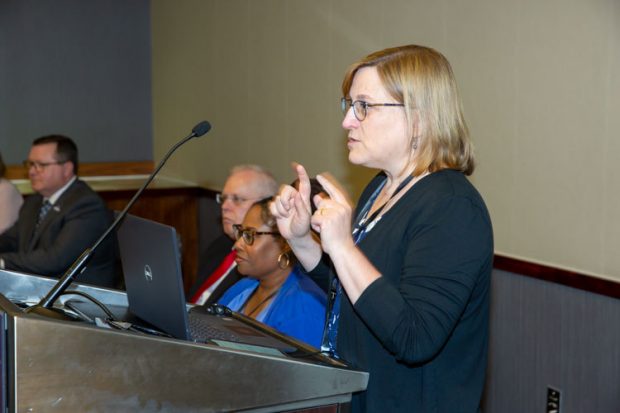
Diane Schrauth, Policy Director for Water at New Jersey Future, moderating the session Ch-Ch-Ch-Changes! How Water Utilities and Communities are Addressing Changing Climate, Changing Regulations and Changing Lead Pipes! during the 2023 NJ Planning and Redevelopment Conference. Photo by Frank H. Conlon
These challenges, and how water utilities are keeping up, were discussed during the session titled ”Ch-Ch-Ch-Changes! How Water Utilities and Communities are Addressing Changing Climate, Changing Regulations and Changing Lead Pipes!” during the 2023 NJ Planning and Redevelopment Conference, co-hosted by New Jersey Future and the New Jersey Chapter of the American Planning Association. Moderated by Diane Schrauth, Policy Director for Water at New Jersey Future, McDonough joined fellow leaders in the water sector, Nicole E Brown, Client Development Manager, Suburban Consulting Engineers; Judy Karp, Assistant Director and Legal and Compliance Officer, New Jersey Infrastructure Bank; and Mark Tompeck, Sr. Vice President and Practice Leader, Water, Mott MacDonald on the panel.
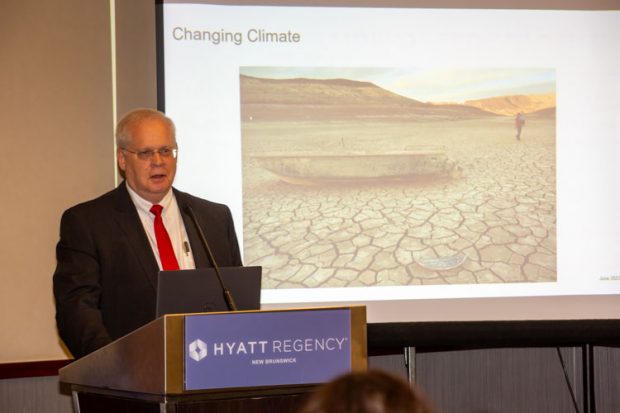
Mark Tompeck, Sr. Vice President and Practice Leader, Water, Mott MacDonald, speaking during the 2023 NJ Planning and Redevelopment Conference. Photo by Frank H. Conlon
Mark Tompeck of Mott MacDonald, a global engineering, management, and development firm, opened the panel by providing an overview of the major environmental challenges necessitating changes in the water sector. As extreme weather events increase in frequency and intensity due to climate change, Tompack explained, the water sector must employ collaboration and long-term planning to ensure system resiliency and prepare for the impact on water quality and quantity. Tompeck pointed out that proposed drinking water standards that would limit two chemicals associated with an increased cancer risk from long-term exposure, per- and polyfluoroalkyl substances (PFAS) and 1,4-dioxane, will require updates to utility equipment and operations. Additionally, Tompeck noted that New Jersey legislation requiring the removal of lead service lines by 2031 is a massive undertaking for utilities as they identify where lead service lines exist, plan for replacement, finance replacement, and communicate with residents.
“Water is the only utility you ingest.”
How are leaders in the water sector navigating these challenges? Mark McDonough (New Jersey American Water) highlighted the importance of consistent investment in water infrastructure, stating “the fact of the matter is…if we didn’t recapitalize our systems on a regular basis…they can’t take the stress and pressure of operating under those conditions.” To communicate these changes with the public, he advised utilities to “go out into the communities, have a conversation,” and “don’t be afraid that people may challenge you.”
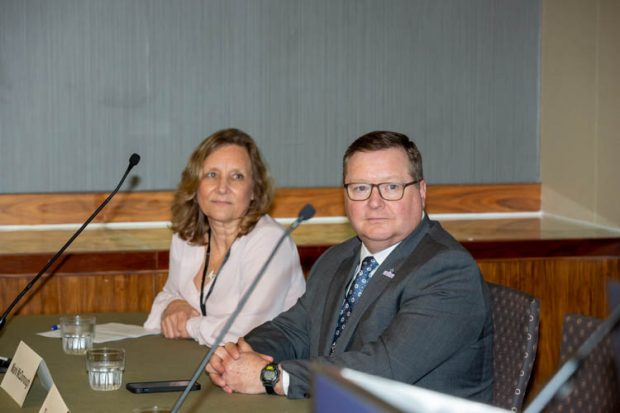
Mark McDonough, President, New Jersey American Water, and Judy Karp, Assistant Director and Legal and Compliance Officer, New Jersey Infrastructure Bank, on the panel for the session Ch-Ch-Ch-Changes! How Water Utilities and Communities are Addressing Changing Climate, Changing Regulations and Changing Lead Pipes! during the 2023 NJ Planning and Redevelopment Conference. Photo by Frank H. Conlon
Nicole E. Brown (Suburban Consulting Engineers) expressed the need for greater access to funding for water systems and spoke to the importance of detailed planning for stakeholder engagement when reaching out to community members. “Who are your stakeholders?” she probed, “What does your school nurse think of it? What does a parent think of it? What does a kid think of it?” Brown also emphasized the value of diversifying the majority white, male water workforce to foster innovative solutions, commenting, “that level of appreciation of the voices in the room that lead to the innovation is what we as an industry have to do.”
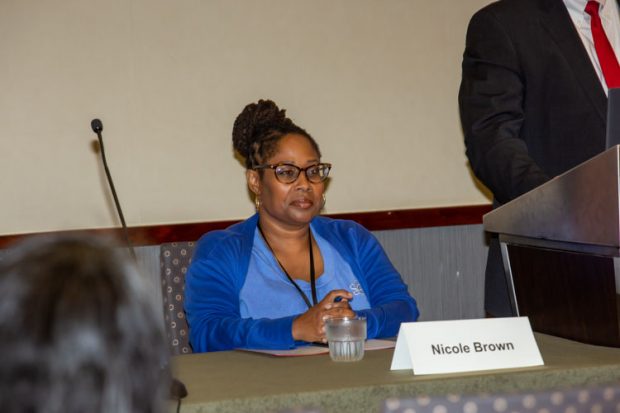
Nicole E Brown, Client Development Manager, Suburban Consulting Engineers, on the panel for the session Ch-Ch-Ch-Changes! How Water Utilities and Communities are Addressing Changing Climate, Changing Regulations and Changing Lead Pipes! during the 2023 NJ Planning and Redevelopment Conference. Photo by Frank H. Conlon
How can water systems meet the funding demands of these necessary infrastructure changes? Judy Karp (New Jersey Infrastructure Bank) encouraged water utilities to apply for financing through the New Jersey Infrastructure Bank (I-Bank), highlighting their technical assistance programs and principal loan forgiveness for projects that address lead and PFAS. “There is a lot of money coming through our programs right now through BIL [Bipartisan Infrastructure Law] and ARPA [American Rescue Plan Act],” she explained. Karp also announced that I-Bank has applied for funds from the Federal Emergency Management Agency (FEMA) to issue bonds for the financing of hazard mitigation and resilience projects.
Managing water and wastewater systems is a complex task and important to consider as localities plan for their future. In this panel, water leaders described how they address the simultaneous impacts of climate change, emerging chemical contaminants, and lead service line replacements through long-term planning, capital investments, new technology, collaboration, building public trust, and diversifying the workforce. Tompeck commented during the session, issues such as micro-plastic contamination and lead in household plumbing fixtures are not currently regulated, but pose concerns for public health and the water sector. As we look toward the future of water infrastructure in New Jersey, these methods will remain necessary as new challenges arise.
Planning for Climate Resilient Stormwater Infrastructure
July 17th, 2023 by Patricia Dunkak
“Watersheds are not political and do not follow political delineations,” said Mayor Andrew Nowick from the City of Lambertville at the 2023 NJ Planning and Redevelopment Conference (NJPRC). As flooding increases due to increased intense rain events and aging stormwater infrastructure, it is more important than ever to plan ahead to protect all New Jerseyans in the face of climate change. A recent NJ Department of Environmental Protection (NJDEP) and Northeast Regional Climate Center study found that the 100-year storms are projected to increase as much as 50%, placing areas not previously in flood zones at risk of severe flooding. Additionally, many waterways in NJ are impaired, which is due in part to non-point source pollution generated by stormwater runoff that is worsened by large quantities of impervious cover. Stormwater rules and permits are being updated in New Jersey to manage both current and future storms, and are encouraging holistic watershed planning and regional solutions, since stormwater, as noted above, does not follow municipal boundaries.
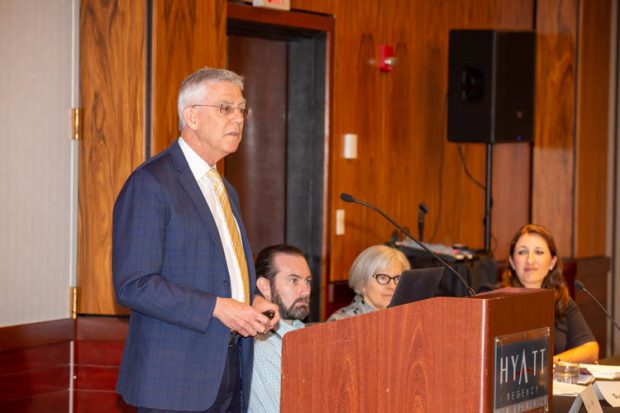
Clinton Andrews speaking during the Upstream/Downstream: Redevelopment or Retreat? Flood Protection Rules, Planning, and Mitigation session at the 2023 NJ Planning Redevelopment Conference. Photo by Frank H. Conlon
Two expert panels explored state stormwater permits and regulations, watershed planning, financial impacts, case studies, and solutions at the 2023 NJPRC sponsored by New Jersey Future and the New Jersey chapter of the American Planning Association. The session Upstream/Downstream: Redevelopment or Retreat? Flood Protection Rules, Planning, and Mitigation featured Clinton Andrews, Associate Dean for Research at Edward J. Bloustein School of Planning & Public Policy, Rutgers University, Gabriel Mahon, Bureau Chief of NJPDES Stormwater Permitting and Water Quality Management, NJDEP, Jennifer Phillips Smith, Director & Co-Chair of Real Estate Group, Gibbons P.C., and Susan Bristol, the Municipal Policy Specialist at The Watershed Institute. The session A Watershed Moment: Planning and Funding Stormwater Improvement Projects featured Mayor Nowick from the City of Lambertville, Bill Cesanek, Vice President of CDM Smith, Gabriel Mahon, Bureau Chief of NJPDES Stormwater Permitting and Water Quality Management, NJDEP, James Thompson, Campaigns Director, NJ League of Conservation Voters, and Lindsey Sigmund, Program Manager at New Jersey Future.
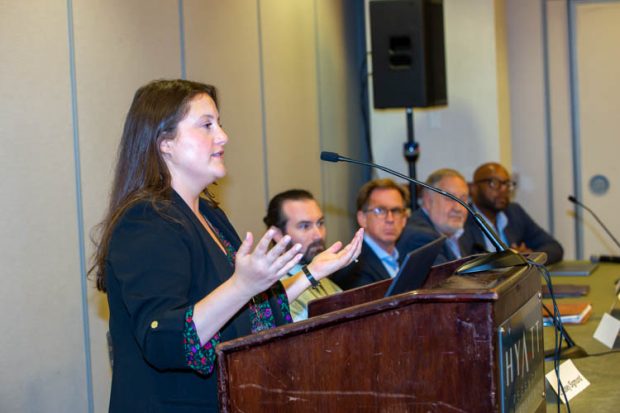
Lindsey Sigmund speaking during the A Watershed Moment: Planning and Funding Stormwater Improvement Projects session at the 2023 NJ Planning Redevelopment Conference. Photo by Frank H. Conlon
NJDEP’s Gabe Mahon provided attendees with an overview of how the state is planning to enhance climate resilient stormwater infrastructure. NJDEP issued the updated Tier A Municipal Separate Storm Sewer System (MS4) Permit, effective on January 1, 2023, which represents a major change from previous MS4 permits with the addition of a Watershed Improvement Plan requirement aimed at improving water quality and reducing flooding. This three-phased requirement includes the mapping of all stormwater infrastructure, including green infrastructure; outlining water quality improvement projects; and a final report that summarizes proposed projects, implementation schedules, and expected costs.
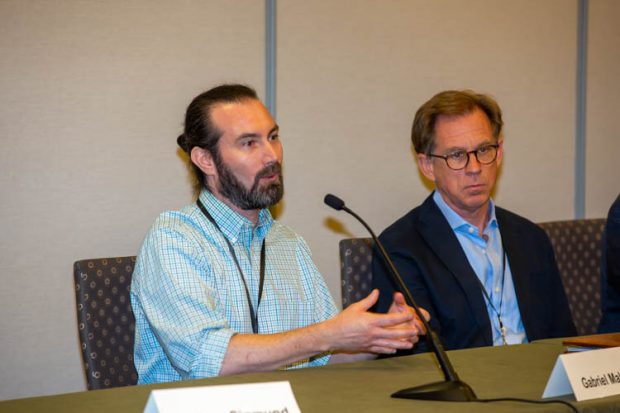
Gabriel Mahon, Bureau Chief of NJPDES Stormwater Permitting and Water Quality Management, NJDEP, speaking during the 2023 NJ Planning Redevelopment Conference. Photo by Frank H. Conlon
Another large rule change at the state is New Jersey Protection Against Climate Threats (NJ PACT), which directed NJDEP to incorporate climate change data into its regulatory and permitting programs. Phase 1 of the rule, the Inland Flood Protection Rules proposed in December 2022 and will be effective in July 2023, requires the use of updated precipitation data to analyze flood potential and design stormwater infrastructure, including green infrastructure. This rule will amend the Stormwater Management Rules, N.J.A.C. 7.8 and the Flood Hazard Area Control Act Rules, N.J.A.C. 7:13. The updated stormwater rules will require systems to be designed to manage both current and future storms. The updated permit and major rule changes will impact how and where development and redevelopment occur, which will lead to more climate resilient stormwater infrastructure.
The resiliency of our infrastructure impacts its ability to mitigate and adapt to climate change. Bloutstien’s Associate Dean Andrews emphasized that flooding not only impacts the environment, but also has municipal fiscal and economic implications. Three climate change adaptation strategies included in his presentation are: resist, accommodate, or retreat. Retreat is often a politically unfavorable strategy, but there are successful examples of retreat demonstrated by NJDEP’s Blue Acres program in the Borough of Manville Borough, Township of Wayne, and Township of Old Bridge. Blue Acres protects community members and the environment by relocating NJ families whose homes experience repeat flooding and acquire their property to be used as open space and flood storage. These municipal decisions play out in a regional watershed context.
Susan Bristol, from the Watershed Institute, emphasized the importance of changing the way we develop, which is very important in a highly developed state like NJ with large areas of impervious cover. Human development has changed the natural water cycle and has increased stormwater runoff that contributes to impaired water quality. “Unbuilding” impervious cover and redevelopment can improve stormwater management, meet requirements of the Stormwater Management Rules, and restore watersheds. While large buyouts and redevelopment occur, Jennifer Phillips Smith reminds us that these projects must be economically feasible for the water quality and restoration benefits to occur when these projects are implemented.

Mayor Nowick from the City of Lambertville speaking during the 2023 NJ Planning Redevelopment Conference. Photo by Frank H. Conlon
Mayor Nowick emphasized that areas not previously in a recorded flood zone are experiencing severe flooding, as seen in the City of Lambertville during Hurricane Ida. Unfortunately, flooding events like these are projected to increase due to aging water infrastructure and large areas of impervious surface. The city is using software supplied by NJDEP to map all of their stormwater infrastructure, but they still face limitations, such as staff capacity, resources, and funding. Stormwater and flooding do not follow municipal boundaries, so regional and watershed level planning are important approaches to improving water quality and reducing flooding.
Bill Cesanek underscored the importance of a holistic, integrative, and long-term watershed based planning process that is cost effective to municipalities and improves environmental health. “Watershed Improvement Planning is a key element of integrated water resource and water quality management.” A paradigm shift is required to incorporate watershed improvement planning into sustainable Master Plans. Planners, engineers, community advocates and members are all needed to work together to assist municipalities to manage stormwater, define the Level of Service needed, and meet state level requirements. It is important that watershed improvement planning is equitable, inclusive, and fairly distributes the environmental, social, and economic benefits.
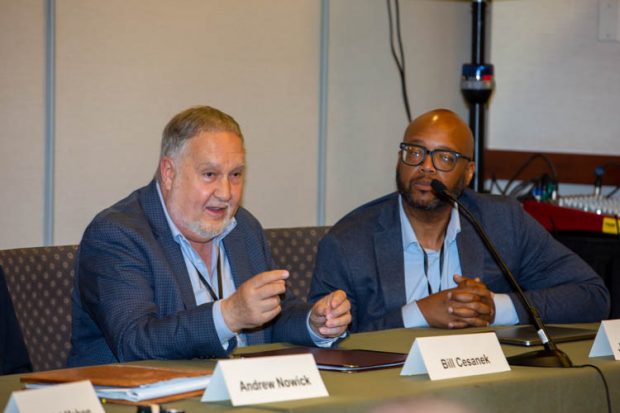
Bill Cesanek, Vice President of CDM Smith, speaking during the 2023 NJ Planning Redevelopment Conference. Photo by Frank H. Conlon
Stormwater infrastructure improvements will be expensive, but there are funding mechanisms and technical assistance available to help municipalities. NJDEP announced the availability of $19 million in stormwater assistance grants to help municipalities comply with new Tier A MS4 permit requirements, such as the mapping of all stormwater infrastructure, as Lambertville is currently undertaking. Additional funding will be necessary, and one viable option for local entities is to establish a stormwater utility. A stormwater utility is a dedicated and equitable funding mechanism to pay for a community’s stormwater management program. As James Thompson explained, there are over 2000 stormwater utilities formed in the United States, but none in NJ so far. In 2019, NJ enacted the Clean Stormwater & Flood Reduction Law that allows municipalities, counties, groups of municipalities, and sewerage and improvement authority to establish a stormwater utility. Last year, NJDEP announced the availability of Technical Assistance for Stormwater Utility Feasibility Studies, which will assist municipalities in completing a stormwater utility feasibility study.
Impaired waterways, large areas of impervious cover and development, and extreme rain events that cause severe flooding demand NJ to holistically approach watershed planning. Expert panelists at the Planning and Redevelopment Conference highlighted state level permits and rules aimed at improving water quality, climate change adaptation strategies, watershed and regional improvement planning, and funding opportunities to upgrade outdated stormwater infrastructure. New state regulations will change where and how we develop, and the solutions described will create more climate resilient infrastructure. The case studies explored and lessons learned are one step toward improving NJ’s water quality, reducing flooding, and improving quality of life in NJ.











